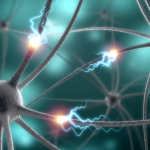The brain is divided into six lobes, or sections: frontal, parietal, occipital, temporal, limbic and insular cortex.
:max_bytes(150000):strip_icc():format(webp)/brain-lobes-574f3e7b3df78c9b46f4a6e2.jpg)
As it sounds, the frontal lobe lies at the front of the brain. If you could look through the skull it would begin right behind the eyebrows, travel up the forehead and then cover about one-third of the top of the head.
According to researchers, the frontal lobe is responsible for shaping observable behavior and personal characteristics. It controls things such as personality, voluntary movements, impulse control, problem-solving, motivation, sexual and social behaviors.
The left and right sides of the frontal lobe handle some different functions. The right frontal lobe is primarily associated with non-verbal skills, such as interpreting social cues. The left frontal lobe has greater control over language expression.
Both the right and left sides of the frontal lobe communicate with each other, so damage to both sides tends to have more profound effects.
Head Trauma and the Frontal Lobe
The frontal lobe is one of the most common areas of the brain to be affected by a head trauma.
Mechanisms of frontal lobe head trauma include having the head:
- Hit the dashboard of a car.
- Strike the front handlebars of a bicycle.
- Impact the ground when thrown from a motorcycle.
- Strike a tree or other immobile object during sports.
- Receive a blow from an assault.
When the front part of the skull impacts an object the skull may or may not break. If the skull fractures, this is called an open injury. An open skull fracture over the frontal lobe may push bone fragments into brain tissue. It also increases the risk of infection, because bacteria, fungi, and other infectious organisms can now come into contact with the brain.
An open fracture may need to be surgically repaired. Any foreign bodies that entered the brain need to be removed, bleeding has to be stopped and the wound needs to be stabilized and closed.
A closed frontal lobe injury means that the skull was not broken or punctured. The damage to the brain may still be serious if the impact caused bleeding or tearing of any of the nerves and tissues. If there is serious bleeding which leads to pressure on the brain, surgery may be needed to stop the bleed and remove the blood.
Long-Term Effects of Frontal Brain Injury
Damage to the frontal lobe can lead to a variety personality changes. Some of these include:
- Making inappropriate comments.
- Alteration in patience and tolerance of others.
- Depression.
- Not responding appropriately to social cues.
- Socially inappropriate sexual comments or behaviors.
- Increased or decreased interest in sex.
- Insomnia.
- Attention and concentration problems.
- Difficulty solving complex problems.
- Slowed critical thinking.
- Increased or decreased talkativeness.
- Lack of spontaneous facial expression.
- Movement impairments.
- Language difficulty.
- Impulsive, dangerous behaviors.
- Substance abuse.
Frontal lobe damage from head trauma manifests in many different ways, depending on the severity of the injury, what sections of the frontal lobe were injured, and pre-existing personality traits.
Treatment of Frontal Lobe Brain Trauma
With any type of head trauma treatment and brain injury management, the initial interventions focus on stopping bleeding and managing swelling and nerve death.
There are a number of diagnostic tools for head trauma and brain injury. It’s common to have both an x-ray and CT scan immediately after the injury. Next, a magnetic resonance imaging (MRI) scan may be used to further identify which areas of the brain suffered damage.
Since the front part of the brain is so closely related to behavior, a neuropsychologist may complete a number of personality and skill tests. This helps determine which skills remain and which need re-training. Interviews with the patient, family, and friends help the medical team and therapist understand how the head injury victim changed from the injury.
From there, a brain injury rehabilitation plan is developed to bridge that gap and bring the person as closely back to their original functional state as possible.
.https://www.verywellhealth.com/frontal-lobe-head-trauma-1720020


